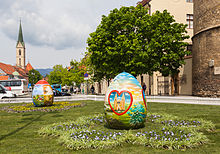Egg decorating


Egg decorating is the art or craft of decorating eggs. It is quite a popular art/craft form because of the attractive, smooth, oval shape of the egg. Any bird egg can be facilitated in this process, but most often the larger and stronger the eggshell is, the more favoured it will be by decorators.
Varieties
This section needs additional citations for verification. (April 2018) |
Goose, duck and hens' eggs are usually "blown" – a hole is made in each end and the contents are blown out. The egg is then either carved, dyed, painted, appliqued or otherwise decorated (using a number of different techniques). Egg decoration is particularly popular in Eastern European countries.
Some eggs, like emu or ostrich eggs, are so large and strong that the shells may be carved without breaking. Decorations on emu eggs take advantage of the contrast in colours between the dark green mottled outside of the shell and the shell-underlay. The oldest eggshells, decorated with engraved hatched patterns, are dated for 60 000 years ago and were found at Diepkloof Rock Shelter in South Africa.[1]
Eastern European cultures, and particularly Slavic ones, also have a strong tradition of decorating eggs. Chicken, duck and goose eggs are decorated variously with batik dyeing, applique, scratch-work, wax encaustic and carving. The renowned Russian court artist and jeweller Peter Carl Fabergé made exquisitely decorated precious metal and gemstone eggs for the Romanovs. These Fabergé eggs resembled standard decorated eggs, but they were made from gold and precious stones.

The Persian culture also has a tradition of egg decorating, which takes place during the spring equinox. This time marks the Persian New Year, and is referred to as Nowruz. Family members decorate eggs together and place them in a bowl. It is said that it is from this cultural tradition that the Christian practice originates.
In Egypt, it is a tradition to decorate boiled eggs during Sham el-Nessim, a spring-ushering national holiday celebrated by Egyptians regardless of religion, which falls every year after the Eastern Christian Easter.
Although some Orthodox Christian societies sometimes richly decorate their eggs at Easter, like the Ukrainian ones as shown, it is more normal to dye eggs red all over, using onion skins.
Many modern egg artists decorate their "art eggs" by etching or carving, while others paint or cover their eggs with different materials, from paper and fabric to polymer clay and are often painted in bright, spring colours. Using eggs as a canvas has become so popular that special terms have developed with the art form.[2] Egg artists also have their own guild, the International Egg Art Guild, which promotes the craft of egg artistry.
In the United States there are shows in many states where artists show their eggs and vendors of "egging" supplies can be found. Each year, the White House chooses a decorated egg from each state to display at easter.
Another type of egg decoration is egg shoeing, which requires goose eggs and miniature horse-shoes, made of iron or lead. The current world record of egg shoeing is 1119 shoes on a single ostrich egg.[3]
In Australia, emu eggs are carved and the art created by them is known as kalti paarti carving.[4]
See also
- Cascarones, hollowed eggs filled with confetti, from Mexico
- Kalti paarti carving, method of decorating emu eggs in Australia
- Egg decorating in Slavic culture
- Polish pisanka
- Croatian pisanica
- Ukrainian pysanka
- Czech Kraslice
- Easter egg
- Washi egg, an egg decorated using washi paper
- Traditional games with decorated eggs
References
- ^ Texier PJ, Porraz G, Parkington J, Rigaud JP, Poggenpoel C, Miller C, Tribolo C, Cartwright C, Coudenneau A, Klein R, Steele T, Verna C. (2010). "A Howiesons Poort tradition of engraving ostrich eggshell containers dated to 60,000 years ago at Diepkloof Rock Shelter, South Africa". Proceedings of the National Academy of Sciences USA. doi:10.1073/pnas.0913047107 PMID 20194764
- ^ "80 Creative and Fun Easter Egg Decorating and Craft Ideas". DIY & Crafts. Retrieved 17 January 2015.
- ^ Home page of the world recorder, József Koszpek
- ^ South, Barrina (11 March 2015). "Kalti Paarti: Carved emu eggs". Australian Museum. Retrieved 2018-08-02.
